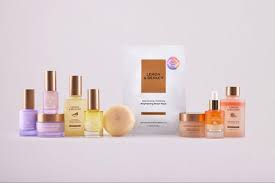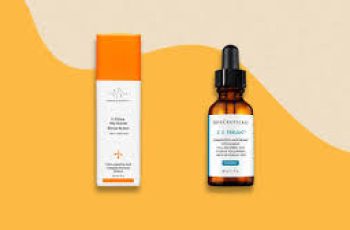
Can You Use Niacinamide and Glycolic Acid Together?
When it comes to skincare, the amount of advice and information available can be overwhelming. You’ve probably come across conflicting opinions about how to layer ingredients and which ones work well together.
If you’ve been tempted to slather every product you own in hopes of instant results, you might want to pump the brakes.
Mixing active ingredients, like glycolic acid and niacinamide, without understanding how they interact can lead to skin irritation or other unwanted reactions.
Though both niacinamide and glycolic acid offer impressive skin benefits, using them together requires a bit of care.
In this article, we’ll explore whether you can use niacinamide and glycolic acid together in your skincare routine, how to do so effectively, and what other combinations work well with these ingredients.
What Is Glycolic Acid and What Does It Do for Your Skin?
Glycolic acid is a powerful alpha hydroxy acid (AHA) that is commonly used in skincare products. Derived from sugarcane, it is a potent exfoliant that removes dead skin cells from the surface of your skin.
Exfoliation is key for maintaining smooth, bright, and healthy-looking skin, and glycolic acid is one of the best at doing this.
Exfoliation: Glycolic acid helps shed dead skin cells, revealing fresh skin underneath.
Fights Breakouts: By clearing pores and reducing excess oil, it helps prevent acne and blackheads.
Smooths Fine Lines: Glycolic acid stimulates collagen production, reducing the appearance of fine lines and wrinkles.
Improves Skin Tone: It helps even out skin tone by sloughing away the build-up of dead cells that can make your skin look dull.
Boosts Absorption: After using glycolic acid, your skin becomes more absorbent, allowing other products to penetrate more effectively.
What Is Niacinamide and What Does It Do for Your Skin?
Niacinamide, also known as Vitamin B3, is a multifunctional ingredient that can address a variety of skin concerns. This powerhouse ingredient is known for its calming and repairing effects on the skin.
Hydration: Niacinamide helps your skin retain moisture by strengthening the skin’s natural barrier.
Oil Control: It regulates sebum production, making it especially beneficial for those with oily or acne-prone skin.
Brightening: Niacinamide can reduce the appearance of hyperpigmentation, dark spots, and uneven skin tone.
Anti-Aging: It helps improve skin elasticity and reduces the appearance of fine lines.
Calming: Niacinamide helps to soothe irritated skin, making it a great ingredient for sensitive skin.
Together, glycolic acid and niacinamide can help smooth skin texture, reduce breakouts, and tackle signs of aging and hyperpigmentation.
However, they each work differently, and understanding how they interact is key to using them together without causing irritation.
Can You Mix Glycolic Acid and Niacinamide?
Yes, you can mix glycolic acid and niacinamide in your skincare routine, but there are important steps to follow to avoid irritation.
The main issue with using these two ingredients together lies in their differing pH levels. Glycolic acid is an acidic ingredient, whereas niacinamide is more alkaline.
This difference in pH can affect how well each ingredient absorbs into the skin and may cause irritation if applied at the same time.
So, while these ingredients don’t chemically “cancel each other out,” they do need to be used thoughtfully to get the best results.
How Do You Use Niacinamide and Glycolic Acid Together?
To use niacinamide and glycolic acid effectively, timing and the order of application are essential. Here’s a step-by-step breakdown:
Apply Glycolic Acid First: Glycolic acid should be applied first because it works to exfoliate the skin and unclog pores.
This step will help the niacinamide (or any other ingredients you use later) penetrate more deeply into the skin.
Wait a Few Minutes: After applying glycolic acid, give your skin 5 to 30 minutes to absorb it and allow its exfoliating action to work. The higher the pH of the ingredient, the longer it takes to be absorbed.
Apply Niacinamide: After allowing glycolic acid to settle, apply niacinamide. Because niacinamide has a higher pH and is more alkaline, it will take longer to absorb into the skin.
This gives the glycolic acid enough time to work before niacinamide is layered on top.
This simple process will help ensure both ingredients work effectively without causing irritation or compromising your skin’s pH balance.
What Should You Avoid Mixing with Niacinamide?
Niacinamide is an excellent addition to most skincare routines, but there are some ingredients that may not work well when combined with it.
While glycolic acid can be used with niacinamide, there are other common ingredients you should be careful with:
Vitamin C: Vitamin C, or ascorbic acid, is a potent antioxidant that is highly acidic.
When used together with niacinamide, it can reduce the effectiveness of both ingredients and cause irritation for some skin types.
Acids with Low pH: Strong acids, like AHAs (lactic, citric acid) and BHAs (salicylic acid), can cause irritation when layered directly over niacinamide.
Retinol: Retinol is another powerful active ingredient that may irritate when used with niacinamide, though some people find it can work when spaced out in their routine.
For a more comprehensive list of ingredients that should be avoided, check out our dedicated blog post on what not to mix with niacinamide.
What Goes Well with Glycolic Acid?
Glycolic acid works well with several other skincare ingredients. However, it’s crucial to consult with your dermatologist to ensure the combinations are appropriate for your skin type and concerns. Below are some excellent pairings with glycolic acid:
Glycolic Acid & Salicylic Acid
Both salicylic acid (BHA) and glycolic acid (AHA) are exfoliants, but they work differently.
Glycolic acid removes dead skin cells from the surface of the skin, while salicylic acid penetrates deeper into the pores to clear out impurities.
This combination is perfect for oily, acne-prone skin, as it targets breakouts at multiple levels.
Glycolic Acid & Lactic Acid
While glycolic acid and lactic acid are both part of the AHA family, they have different molecular sizes.
Lactic acid has a larger molecule and works more on the surface of the skin, while glycolic acid can penetrate deeper layers.
Together, they exfoliate both the surface and the deeper layers, giving your skin a comprehensive refresh.
Glycolic Acid & Hyaluronic Acid
Hyaluronic acid is a humectant that draws moisture into the skin, making it an excellent hydrating partner for glycolic acid.
Since glycolic acid can sometimes cause dryness or irritation, hyaluronic acid helps replenish moisture and soothe the skin. This makes for a perfect combination to keep your skin smooth and hydrated.
Can Niacinamide Be Used with AHA/BHA?
Yes, niacinamide can be used with AHAs and BHAs, but caution is advised.
The reason is that AHAs and BHAs are highly acidic, and when layered with niacinamide, they may lead to irritation, especially if the skin barrier is already compromised.
Always allow sufficient time between applying these products, and consider alternating their use to avoid potential irritation.
Can I Use Glycolic Acid Every Day?
Glycolic acid can be used daily, but it depends on your skin’s tolerance. Normal, combination, and oily skin types are more likely to tolerate daily use of glycolic acid.
If you have dry or sensitive skin, it may be best to start with a few times per week and gradually build up your tolerance.
Can I Use Moisturizer After Glycolic Acid?
Absolutely! After applying glycolic acid, it’s important to follow up with a moisturizer to help lock in hydration and protect the skin barrier.
Glycolic acid can cause some dryness, so using a moisturizer will keep your skin smooth and hydrated while forming a protective barrier against environmental stressors.
Final Thoughts
So, can you use niacinamide and glycolic acid together? Yes, with proper care and timing, these two powerhouse ingredients can be part of a highly effective skincare routine.
By following the right order of application and allowing time for absorption, you can enjoy the benefits of both without irritating your skin.
As always, if you’re introducing new ingredients to your routine, it’s a good idea to perform a patch test first.
And, if you’re ever in doubt, consulting with a dermatologist can help ensure that your skincare routine is tailored to your specific needs.
If you have any more questions or need additional guidance, don’t hesitate to reach out to us on Instagram. We’re always here to help you achieve the healthiest skin possible!


